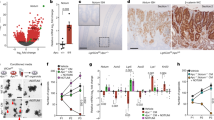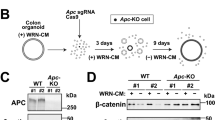Abstract
Intestinal polyposis, a precancerous neoplasia, results primarily from an abnormal increase in the number of crypts, which contain intestinal stem cells (ISCs). In mice, widespread deletion of the tumor suppressor Phosphatase and tensin homolog (PTEN) generates hamartomatous intestinal polyps with epithelial and stromal involvement. Using this model, we have established the relationship between stem cells and polyp and tumor formation. PTEN helps govern the proliferation rate and number of ISCs and loss of PTEN results in an excess of ISCs. In PTEN-deficient mice, excess ISCs initiate de novo crypt formation and crypt fission, recapitulating crypt production in fetal and neonatal intestine. The PTEN-Akt pathway probably governs stem cell activation by helping control nuclear localization of the Wnt pathway effector β-catenin. Akt phosphorylates β-catenin at Ser552, resulting in a nuclear-localized form in ISCs. Our observations show that intestinal polyposis is initiated by PTEN-deficient ISCs that undergo excessive proliferation driven by Akt activation and nuclear localization of β-catenin.
This is a preview of subscription content, access via your institution
Access options
Subscribe to this journal
Receive 12 print issues and online access
$209.00 per year
only $17.42 per issue
Buy this article
- Purchase on Springer Link
- Instant access to full article PDF
Prices may be subject to local taxes which are calculated during checkout







Similar content being viewed by others
Accession codes
References
Reya, T., Morrison, S.J., Clarke, M.F. & Weissman, I.L. Stem cells, cancer, and cancer stem cells. Nature 414, 105–111 (2001).
Lapidot, T. et al. A cell initiating human acute myeloid leukaemia after transplantation into SCID mice. Nature 367, 645–648 (1994).
Al-Hajj, M., Wicha, M.S., Benito-Hernandez, A., Morrison, S.J. & Clarke, M.F. Prospective identification of tumorigenic breast cancer cells. Proc. Natl. Acad. Sci. USA 100, 3983–3988 (2003).
Singh, S.K. et al. Identification of human brain tumour initiating cells. Nature 432, 396–401 (2004).
Potten, C.S., Owen, G. & Booth, D. Intestinal stem cells protect their genome by selective segregation of template DNA strands. J. Cell Sci. 115, 2381–2388 (2002).
Radtke, F. & Clevers, H. Self-renewal and cancer of the gut: two sides of a coin. Science 307, 1904–1909 (2005).
Brittan, M. & Wright, N.A. Gastrointestinal stem cells. J. Pathol. 197, 492–509 (2002).
Bjerknes, M. & Cheng, H. Clonal analysis of mouse intestinal epithelial progenitors. Gastroenterology 116, 7–14 (1999).
He, X.C. et al. BMP signaling inhibits intestinal stem cell self-renewal through suppression of Wnt-beta-catenin signaling. Nat. Genet. 36, 1117–1121 (2004).
Haramis, A.P. et al. De novo crypt formation and juvenile polyposis on BMP inhibition in mouse intestine. Science 303, 1684–1686 (2004).
Greaves, L.C. et al. Mitochondrial DNA mutations are established in human colonic stem cells, and mutated clones expand by crypt fission. Proc. Natl. Acad. Sci. USA 103, 714–719 (2006).
Howe, J.R. et al. Germline mutations of the gene encoding bone morphogenetic protein receptor 1A in juvenile polyposis. Nat. Genet. 28, 184–187 (2001).
Sancho, E., Batlle, E. & Clevers, H. Signaling pathways in intestinal development and cancer. Annu. Rev. Cell Dev. Biol. 20, 695–723 (2004).
van de Wetering, M. et al. The beta-catenin/TCF-4 complex imposes a crypt progenitor phenotype on colorectal cancer cells. Cell 111, 241–250 (2002).
Liaw, D. et al. Germline mutations of the PTEN gene in Cowden disease, an inherited breast and thyroid cancer syndrome. Nat. Genet. 16, 64–67 (1997).
Stiles, B., Groszer, M., Wang, S., Jiao, J. & Wu, H. PTENless means more. Dev. Biol. 273, 175–184 (2004).
Zhou, X.P. et al. Germline mutations in BMPR1A/ALK3 cause a subset of cases of juvenile polyposis syndrome and of Cowden and Bannayan-Riley-Ruvalcaba syndromes. Am. J. Hum. Genet. 69, 704–711 (2001).
Waite, K.A. & Eng, C. BMP2 exposure results in decreased PTEN protein degradation and increased PTEN levels. Hum. Mol. Genet. 12, 679–684 (2003).
Tian, Q. et al. Proteomic analysis identifies that 14–3-3ζ interacts with β-catenin and facilitates its activation by Akt. Proc. Natl. Acad. Sci. USA 101, 15370–15375 (2004).
Persad, S., Troussard, A.A., McPhee, T.R., Mulholland, D.J. & Dedhar, S. Tumor suppressor PTEN inhibits nuclear accumulation of beta-catenin and T cell/lymphoid enhancer factor 1-mediated transcriptional activation. J. Cell Biol. 153, 1161–1174 (2001).
Sharma, M., Chuang, W.W. & Sun, Z. Phosphatidylinositol 3-kinase/Akt stimulates androgen pathway through GSK3beta inhibition and nuclear beta-catenin accumulation. J. Biol. Chem. 277, 30935–30941 (2002).
Groszer, M. et al. Negative regulation of neural stem/progenitor cell proliferation by the Pten tumor suppressor gene in vivo. Science 294, 2186–2189 (2001).
Kühn, R., Schwenk, F., Aguet, M. & Rajewsky, K. Inducible gene targeting in mice. Science 269, 1427–1429 (1995).
Potten, C.S. et al. Identification of a putative intestinal stem cell and early lineage marker; musashi-1. Differentiation 71, 28–41 (2003).
Wirtzfeld, D.A., Petrelli, N.J. & Rodriguez-Bigas, M.A. Hamartomatous polyposis syndromes: molecular genetics, neoplastic risk, and surveillance recommendations. Ann. Surg. Oncol. 8, 319–327 (2001).
Vazquez, F. et al. Phosphorylation of the PTEN tail acts as an inhibitory switch by preventing its recruitment into a protein complex. J. Biol. Chem. 276, 48627–48630 (2001).
Gera, J.F. et al. AKT activity determines sensitivity to mammalian target of rapamycin (mTOR) inhibitors by regulating cyclin D1 and c-myc expression. J. Biol. Chem. 279, 2737–2746 (2004).
Passegue, E., Wagner, E.F. & Weissman, I.L. JunB deficiency leads to a myeloproliferative disorder arising from hematopoietic stem cells. Cell 119, 431–443 (2004).
Zhang, J. et al. PTEN maintains hematopoietic stem cells and acts in lineage choice and leukaemia prevention. Nature 441, 518–522 (2006).
Wasan, H.S. et al. APC in the regulation of intestinal crypt fission. J. Pathol. 185, 246–255 (1998).
Wong, W.M. et al. Histogenesis of human colorectal adenomas and hyperplastic polyps: the role of cell proliferation and crypt fission. Gut 50, 212–217 (2002).
Preston, S.L. et al. Bottom-up histogenesis of colorectal adenomas: origin in the monocryptal adenoma and initial expansion by crypt fission. Cancer Res. 63, 3819–3825 (2003).
Shih, I.M. et al. Top-down morphogenesis of colorectal tumors. Proc. Natl. Acad. Sci. USA 98, 2640–2645 (2001).
Tetsu, O. & McCormick, F. Beta-catenin regulates expression of cyclin D1 in colon carcinoma cells. Nature 398, 422–426 (1999).
Liang, J. et al. PKB/Akt phosphorylates p27, impairs nuclear import of p27 and opposes p27-mediated G1 arrest. Nat. Med. 8, 1153–1160 (2002).
Lowry, W.E. et al. Defining the impact of β-catenin/Tcf transactivation on epithelial stem cells. Genes Dev. 19, 1596–1611 (2005).
Cross, D.A., Alessi, D.R., Cohen, P., Andjelkovich, M. & Hemmings, B.A. Inhibition of glycogen synthase kinase-3 by insulin mediated by protein kinase B. Nature 378, 785–789 (1995).
Datta, S.R. et al. 14–3-3 proteins and survival kinases cooperate to inactivate BAD by BH3 domain phosphorylation. Mol. Cell 6, 41–51 (2000).
van Noort, M., Meeldijk, J., van der Zee, R., Destree, O. & Clevers, H. Wnt signaling controls the phosphorylation status of beta-catenin. J. Biol. Chem. 277, 17901–17905 (2002).
Groszer, M. et al. PTEN negatively regulates neural stem cell self-renewal by modulating G0–G1 cell cycle entry. Proc. Natl. Acad. Sci. USA 103, 111–116 (2006).
Yilmaz, O.H. et al. Pten dependence distinguishes haematopoietic stem cells from leukaemia-initiating cells. Nature 441, 475–482 (2006).
Asai, R., Okano, H. & Yasugi, S. Correlation between Musashi-1 and c-hairy-1 expression and cell proliferation activity in the developing intestine and stomach of both chicken and mouse. Dev. Growth Differ. 47, 501–510 (2005).
Gregorieff, A. et al. Expression pattern of Wnt signaling components in the adult intestine. Gastroenterology 129, 626–638 (2005).
Huber, A.H., Nelson, W.J. & Weis, W.I. Three-dimensional structure of the Armadillo repeat region of β-catenin. Cell 90, 871–882 (1997).
Koike, M. β-catenin shows an overlapping sequence requirement but distinct molecular interactions for its bidirectional passage through nuclear pores. J. Biol. Chem. 279, 34038–34047 (2004).
Gottardi, C.J. & Gumbiner, B.M. Distinct molecular forms of beta-catenin are targeted to adhesive or transcriptional complexes. J. Cell Biol. 167, 339–349 (2004).
Piedra, J. et al. Regulation of beta-catenin structure and activity by tyrosine phosphorylation. J. Biol. Chem. 276, 20436–20443 (2001).
Megy, S. et al. Solution structure of a peptide derived from the oncogenic protein β-catenin in its phosphorylated and nonphosphorylated states. Peptides 26, 227–241 (2005).
Trotman, L.C. et al. Identification of a tumour suppressor network opposing nuclear Akt function. Nature 441, 523–527 (2006).
Taurin, S., Sandbo, N., Qin, Y., Browning, D. & Dulin, N.O. Phosphorylation of beta-catenin by cyclic AMP-dependent protein kinase. J. Biol. Chem. 281, 9971–9976 (2006).
Acknowledgements
We are grateful to B. Neaves and R. Krumlauf for scientific support. We thank H. Okano for providing anti-Musashi1 (14-H1) and A. Ouellette for anti-cryptdin; S. Peck and G. Yang for comments on the manuscript; D. di Natale for assistance on manuscript editing; P. Kulesa and D. Stark for imaging assistance; C. Seidel, K. Zueckert-Gaudenz and M. Coleman for assistance in microarray analysis; H. Marshall for technology support and J. Chen for assistance in statistical analysis. L. Li is supported in part by research grant 5-FY05-31 from the March of Dimes Birth Defects Foundation, by grant R01 DK070001 from the National Institute of Diabetes and Digestive and Kidney Diseases and by the Stowers Institute for Medical Research.
Author information
Authors and Affiliations
Contributions
X.C.H., J.C.G. and L.L. designed the research; X.C.H., T.Y., T.S. and J.C.G. performed the research; Q.T., W.A.T. and L.H. performed the mass spectrometry; R.D., K.S.P-W., M.H., T.J. and T.A.B. provided technical support; H.W. contributed critical reagents; J.C.G., L.M.W. and L.L. wrote the paper.
Corresponding author
Ethics declarations
Competing interests
The authors declare no competing financial interests.
Supplementary information
Supplementary Fig. 1
Comparison of expression patterns of p-PTEN, p-Akt, 14-3-3ζ, pGSK3β and Musashi1. (PDF 1831 kb)
Supplementary Fig. 2
Detection of Musashi1 expression using an antibody to Musashi1 (clone 14H1). (PDF 380 kb)
Supplementary Fig. 3
Cluster of Musashi1+ cells detected at the initiation site of crypt budding or crypt fission in PTEN mutants. (PDF 367 kb)
Supplementary Fig. 4
Comparison of expression patterns of pβ-cat-Ser552, Top-Gal, p27kip1 and cyclin D1. (PDF 555 kb)
Supplementary Fig. 5
Distribution of cells with pβ-cat-Ser552. (PDF 414 kb)
Supplementary Video 1
PTEN-deficient stem cells initiate crypt fission. Crypts were dissociated from the polyp region of PTEN mutant intestine. Whole-mount staining was performed using two antibodies: anti-β-cat-S552 (green) to recognize stem cells (normal or abnormal) and anti-cryptdin (red) to recognize Paneth cells. One β-cat-S552+ cell was located just above the Paneth cells in the proposed stem cell position; the other dividing β-cat-S552+ cell was found at the tip of the ridge formed between two dividing crypts. (AVI 2092 kb)
Supplementary Video 2
PTEN-deficient stem cells initiate crypt budding. Crypts were dissociated from the polyp region of PTEN mutant intestine. Whole-mount staining was performed using two antibodies: anti-β-cat-S552 (green) to recognize stem cells (normal or abnormal) and anti-cryptdin (red) to recognize Paneth cells. One β-cat-S552+ cell was located just above the Paneth cells in the proposed stem cell position; a cluster of β-cat-S552+ cells was found at the junction between a budding crypt and the edge of the original crypt. (AVI 2168 kb)
Rights and permissions
About this article
Cite this article
He, X., Yin, T., Grindley, J. et al. PTEN-deficient intestinal stem cells initiate intestinal polyposis. Nat Genet 39, 189–198 (2007). https://doi.org/10.1038/ng1928
Received:
Accepted:
Published:
Issue Date:
DOI: https://doi.org/10.1038/ng1928
This article is cited by
-
Intratumoral microbiota: roles in cancer initiation, development and therapeutic efficacy
Signal Transduction and Targeted Therapy (2023)
-
mTOR inhibition suppresses Myc-driven polyposis by inducing immunogenic cell death
Oncogene (2023)
-
Tumor-associated macrophages promote epithelial–mesenchymal transition and the cancer stem cell properties in triple-negative breast cancer through CCL2/AKT/β-catenin signaling
Cell Communication and Signaling (2022)
-
Combinatorial treatment with statins and niclosamide prevents CRC dissemination by unhinging the MACC1-β-catenin-S100A4 axis of metastasis
Oncogene (2022)
-
Embryonic organizer formation disorder leads to multiorgan dysplasia in Down syndrome
Cell Death & Disease (2022)



